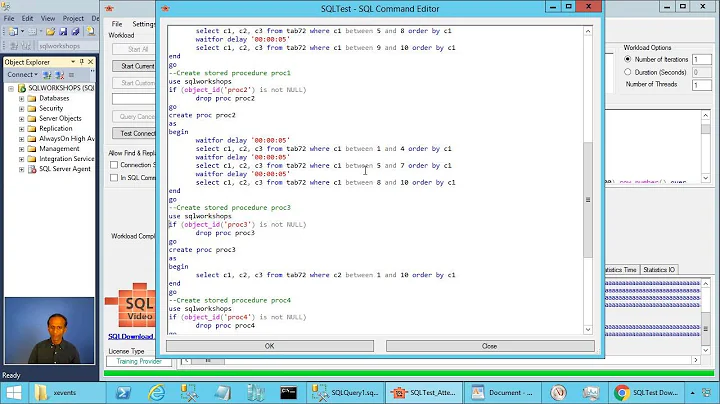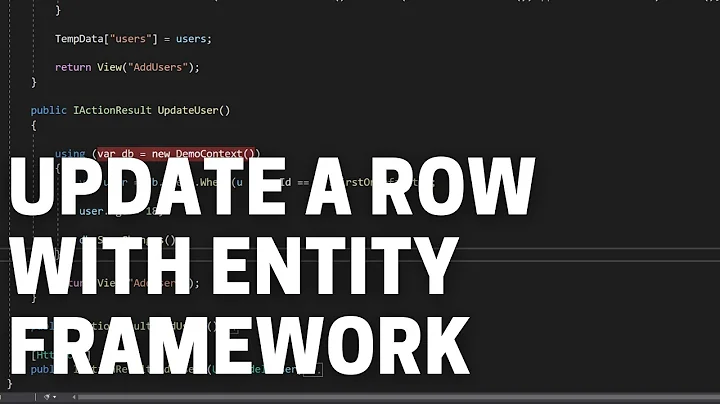Set database timeout in Entity Framework
Solution 1
Try this on your context:
public class MyDatabase : DbContext
{
public MyDatabase ()
: base(ContextHelper.CreateConnection("Connection string"), true)
{
((IObjectContextAdapter)this).ObjectContext.CommandTimeout = 180; // seconds
}
}
If you want to define the timeout in the connection string, use the Connection Timeout parameter like in the following connection string:
<connectionStrings>
<add name="AdventureWorksEntities"
connectionString="metadata=.\AdventureWorks.csdl|.\AdventureWorks.ssdl|.\AdventureWorks.msl;
provider=System.Data.SqlClient;provider connection string='Data Source=localhost;
Initial Catalog=AdventureWorks;Integrated Security=True;Connection Timeout=60;
multipleactiveresultsets=true'" providerName="System.Data.EntityClient" />
</connectionStrings>
Source: How to: Define the Connection String
Solution 2
You can use DbContext.Database.CommandTimeout = 180; // seconds
It's pretty simple and no cast required.
Solution 3
My partial context looks like:
public partial class MyContext : DbContext
{
public MyContext (string ConnectionString)
: base(ConnectionString)
{
this.SetCommandTimeOut(300);
}
public void SetCommandTimeOut(int Timeout)
{
var objectContext = (this as IObjectContextAdapter).ObjectContext;
objectContext.CommandTimeout = Timeout;
}
}
I left SetCommandTimeOut public so only the routines I need to take a long time (more than 5 minutes) I modify instead of a global timeout.
Solution 4
In the generated constructor code it should call OnContextCreated()
I added this partial class to solve the problem:
partial class MyContext: ObjectContext
{
partial void OnContextCreated()
{
this.CommandTimeout = 300;
}
}
Solution 5
For Database first Aproach:
We can still set it in a constructor, by override the ContextName.Context.tt T4 Template this way:
<#=Accessibility.ForType(container)#> partial class <#=code.Escape(container)#> : DbContext
{
public <#=code.Escape(container)#>()
: base("name=<#=container.Name#>")
{
Database.CommandTimeout = 180;
<#
if (!loader.IsLazyLoadingEnabled(container))
{
#>
this.Configuration.LazyLoadingEnabled = false;
<#
}
Database.CommandTimeout = 180; is the acutaly change.
The generated output is this:
public ContextName() : base("name=ContextName")
{
Database.CommandTimeout = 180;
}
If you change your Database Model, this template stays, but the actualy class will be updated.
Related videos on Youtube
James
Updated on July 08, 2022Comments
-
James almost 2 years
My command keeps timing out, so I need to change the default command timeout value.
I've found
myDb.Database.Connection.ConnectionTimeout, but it'sreadonly.How can I set the command timeout in Entity Framework 5 ?
-
 itsho almost 10 yearsFYI, On EF6,
itsho almost 10 yearsFYI, On EF6,Database.CommandTimeoutis no longer read-only -
David Ferenczy Rogožan about 8 years@itsho He was talking about
Database.Connection.ConnectionTimeout. Anyway, I would say thatDatabase.CommandTimeoutis the right thing in the case your query is time-outing (exceptionSystem.Data.Entity.Core.EntityCommandExecutionExceptioncontainingSystem.Data.SqlClient.SqlException: Timeout expired.). -
Tim Pohlmann over 7 yearsPossible duplicate of Entity Framework Timeouts
-
Worthy7 over 6 yearsI assume you actually don't care about the CONNECTION timeout, but instead you want to adjust the COMMAND timeout.
-
-
Kevin Gorski about 11 yearsI would recommend using the connection string version as if you try to access the
ObjectContextin this constructor sometimes the PowerShell/NuGet console commands will fail in a circular way. -
Clay Lenhart almost 11 yearsConnection Timeout and CommandTimeout and two separate things. The connection string setting, Connection Timeout, won't affect the amount of time the command runs (CommandTimeout).
-
user692942 over 10 yearsMight be because this is an answer is a year old but
Connection Timeoutraises anEntityException"The underlying provider failed on Open". The actual valid value isConnect Timeoutbut it appears to be ignored by EF anyway. -
Karsten over 9 yearsMy problem was a litte different. I got timeout during migrations. EF has a similar property to set for using during migrations: msdn.microsoft.com/en-us/library/…
-
Jim Aho over 9 yearsDepending on what version of EF you use, see this answer to get a feeling about the different API's in how to specify the CommandTimeout property.
-
Jezbers almost 9 yearsDoes not work for me (Connection vs Command not being teh same thing I suspect). This post solved it though stackoverflow.com/questions/6232633/entity-framework-timeouts
-
Nebu about 8 yearsMy Connection Timeout was set OK but discovered
CommandTimeoutwas null. I setCommandTimeoutas per @leniel-macaferi 's suggestion and it solved my timeout issue. -So they are not the same thing and both need to be set to enable a custom timeout to be set in EF. -
 cdonner about 8 years@Karsten - thanks for the tip about dbmigrationsconfiguration! I would have tinkered with the context command timeout until the cows come home.
cdonner about 8 years@Karsten - thanks for the tip about dbmigrationsconfiguration! I would have tinkered with the context command timeout until the cows come home. -
 GoldBishop almost 8 yearsVery useful for us that use
GoldBishop almost 8 yearsVery useful for us that useFluent APIform of EF. -
shas over 7 yearsIs there way we can specify timeout in Template using some config file.?
-
 Christian Gollhardt over 7 yearsnot sure, if there something build in (I wasn't able to find something). But instead of hardcoding 180, you can use
Christian Gollhardt over 7 yearsnot sure, if there something build in (I wasn't able to find something). But instead of hardcoding 180, you can useSystem.Configuration.ConfigurationManager.AppSettings["keyname"]@shas -
Thomas Hahn about 7 yearsThe connection string solution leads to "Keyword not supported: 'connection timeout'."
-
Wanderson López about 6 yearsand how do i call this extension method?
-
 Andrew almost 5 yearsYes these are 2 different things command timeout and connection timeout. command timeout is what you want not connection timeout
Andrew almost 5 yearsYes these are 2 different things command timeout and connection timeout. command timeout is what you want not connection timeout -
Gert Arnold about 3 yearsAs noted earlier: connection timeout != command timeout. Command timeout is what matters here.
-
Wael Galal El Deen about 3 yearsThis approach was to read it dynamically from the Connection String rather than making a separate setting for it.
-
Gert Arnold about 3 yearsThat detail escaped my eye, and that immediately shows the problem with such hacks. It's totally unexpected and should never be done.
-
Wael Galal El Deen about 3 yearsThe hacking checks should be done from other places and I thing the command time out of the command should be long enough to execute long queries or SQL commands. So the admin of the website should be able to control this period according to his needs without getting a new publish for just changing the command time out period.
-
Gert Arnold about 3 yearsNOT by abusing the Connection Timeout setting in the connection string! The next application manager will set it to some other value, unaware of its implications. And, remember, it also sets the connection timeout (obviously). You don't want people to wait for 5 minutes if the connection happens to be unavailable due to some contingency.

![MySQL / Entity Framework Core [Create, Update and Delete operations and Stored Procedure using C#]](https://i.ytimg.com/vi/TC5mCIGwDyA/hq720.jpg?sqp=-oaymwEcCNAFEJQDSFXyq4qpAw4IARUAAIhCGAFwAcABBg==&rs=AOn4CLABoUqWAa0gafqNfgGGBCDUYTA4WA)











